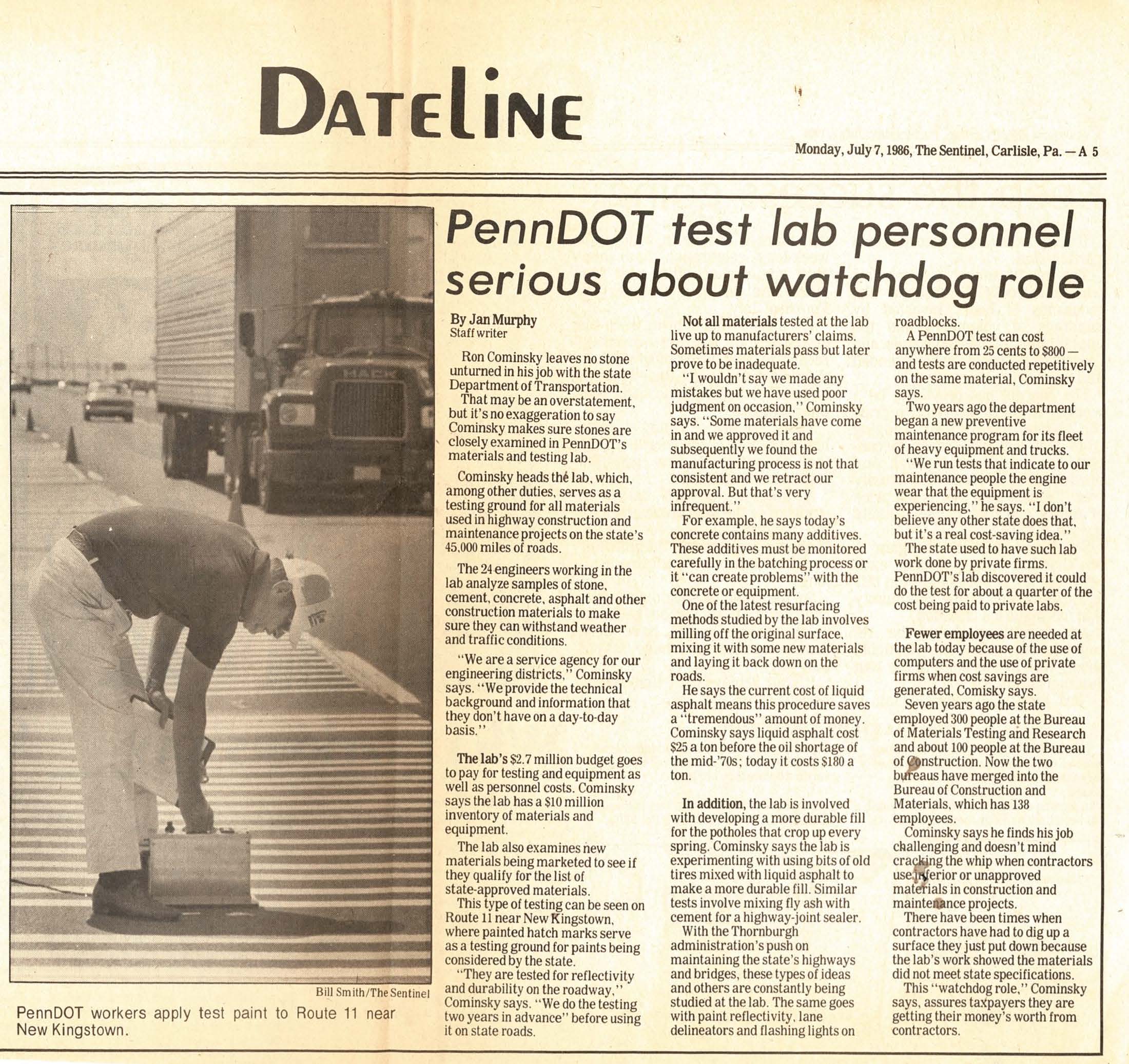Pennsylvania's roads are only as safe at the materials PennDOT uses. That's why we have an entire lab devoted to testing the integrity of those materials.
The department recently discovered an article from
The (Carlisle) Sentinel that ran on Monday, July 7, 1986, written by Jan Murphy. The article talks about our materials testing lab back then. A lot has change in 32 years, but not our commitment to safety.
Here's the text of that entire article:
 Click to view larger.
Click to view larger.
Ron Cominsky leaves no stone unturned in his job with the state Department of Transportation.
That may be an overstatement, but it's no exaggeration to say Cominsky makes sure stones are closely examined in PennDOT's materials and testing lab.
Cominsky heads the lab, which, among other duties, serves as a testing ground for all materials used in highway construction and maintenance projects on the state's 45,000 miles of roads.
The 24 engineers working in the lab analyze samples of stone, cement, concrete, asphalt and other construction materials to make sure they can withstand weather and traffic conditions.
"We are a service agency for our engineering districts," Cominsky says. "We provide the technical background and information that they don't have on a day-to-day basis."
The lab's $2.7 million budget goes to pay for testing and equipment as well as personnel costs. Cominsky says the lab has a $10 million inventory of materials and equipment.
The lab also examines new materials being marketed to see if they qualify for the list of state-approved materials.
This type of testing can be seen on Route 11 near New Kingstown, where painted hatch marks serve as a testing ground for paints being considered by the state.
"They are tested for reflectivity and durability on the roadway." Cominsky says. "We do the testing two years in advance" before using it on state roads.
Not all materials tested at the lab live up to manufacturers' claims. Sometimes materials pass but later prove to be inadequate.
"I wouldn't say we made any mistakes but we have used poor judgment on occasion," Cominsky says. "Some materials have come in and we approved it and subsequently we found the manufacturing process is not that consistent and we retract our approval. But that's very infrequent."
For example, he says today's concrete contains many additives. These additives must be monitored carefully in the batching process or it "can create problems" with the concrete or equipment.
One of the latest resurfacing methods studied by the lab involves milling off the original surface, mixing it with some new materials and laying it back down on the road.
He says the current cost of liquid asphalt means this procedure saves a "tremendous" amount of money. Cominsky says liquid asphalt cost $25 a ton before the oil shortage of the mid-'70s; today it costs $180 a ton.
In addition, the lab is involved with developing a more durable fill for the potholes that crop up every spring. Cominsky says the lab is experimenting with using bits of old tires mixed with liquid asphalt to make a more durable fill. Similar tests involve mixing fly ash with cement for a highway-join sealer.
With the Thornburgh administration's push on maintaining the state's highways and bridges, these types of ideas and others are constantly being studied at the lab. The same goes with paint reflectivity, lane delineators and flashing lights on roadblocks.
A PennDOT test can cost anywhere from 25 cents to $800 – and tests are conducted repetitively on the same material, Cominsky says.
Two years ago, the department began a new preventive maintenance program for its fleet of heavy equipment and trucks.
"We run tests that indicate to our maintenance people the engine wear that the equipment is experiencing," he says. "I don't believe any other state does that, but it's a real cost-saving idea."
The state used to have such lab work done by private firms. PennDOT's lab discovered it could do the test for about a quarter of the cost being paid to private labs.
Fewer employees are needed at the lab today because of the use of computers and the use of private firms when cost savings are generated, Cominsky says.
Seven years ago the state employed 300 people at the Bureau of Materials Testing and Research and about 100 people at the Bureau of Construction. Now the two bureaus have merged into the Bureau of Construction and Materials, which has 138 employees.
Cominsky says he finds his job challenging and doesn't mind cracking the whip when contractors use inferior or unapproved materials in construction and maintenance projects.
There have been times when contractors have had to dig up a surface they just put down because the lab's work showed the materials did not meet state specifications.
This "watchdog role," Cominsky says, assures taxpayers they are getting their money's worth from contractors.